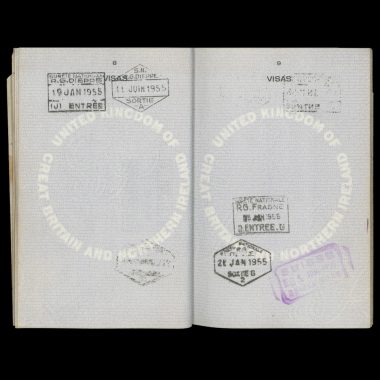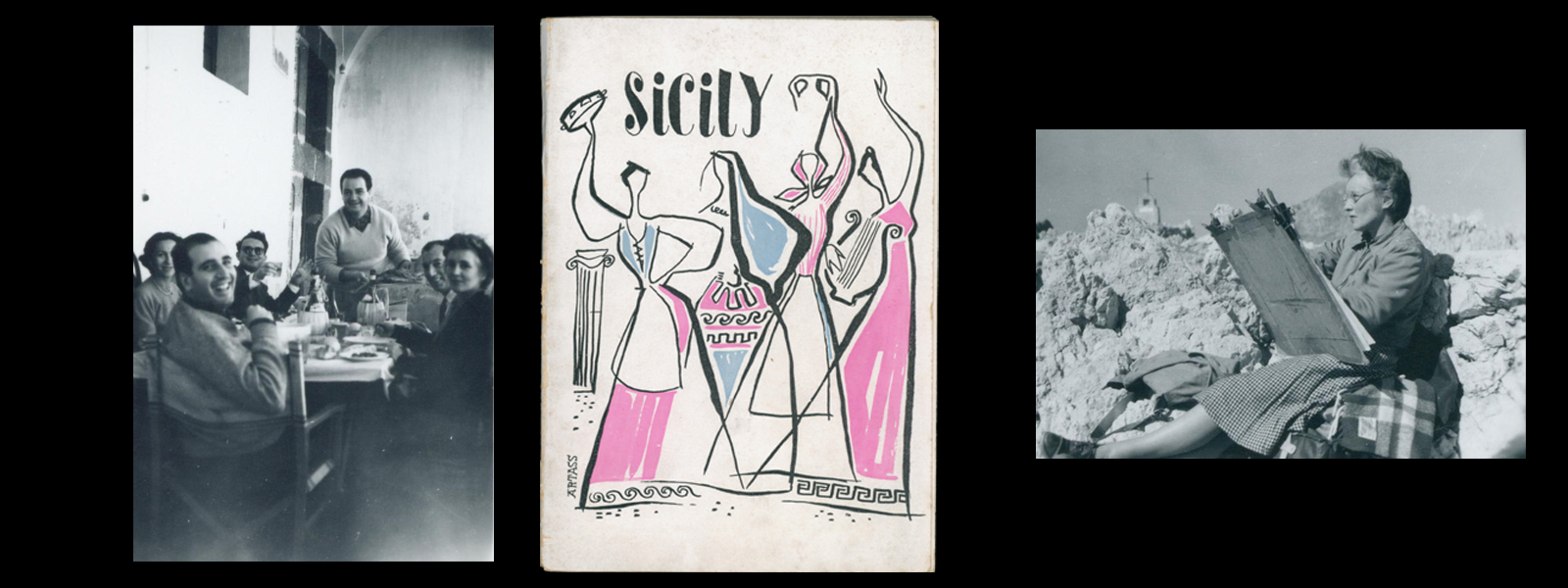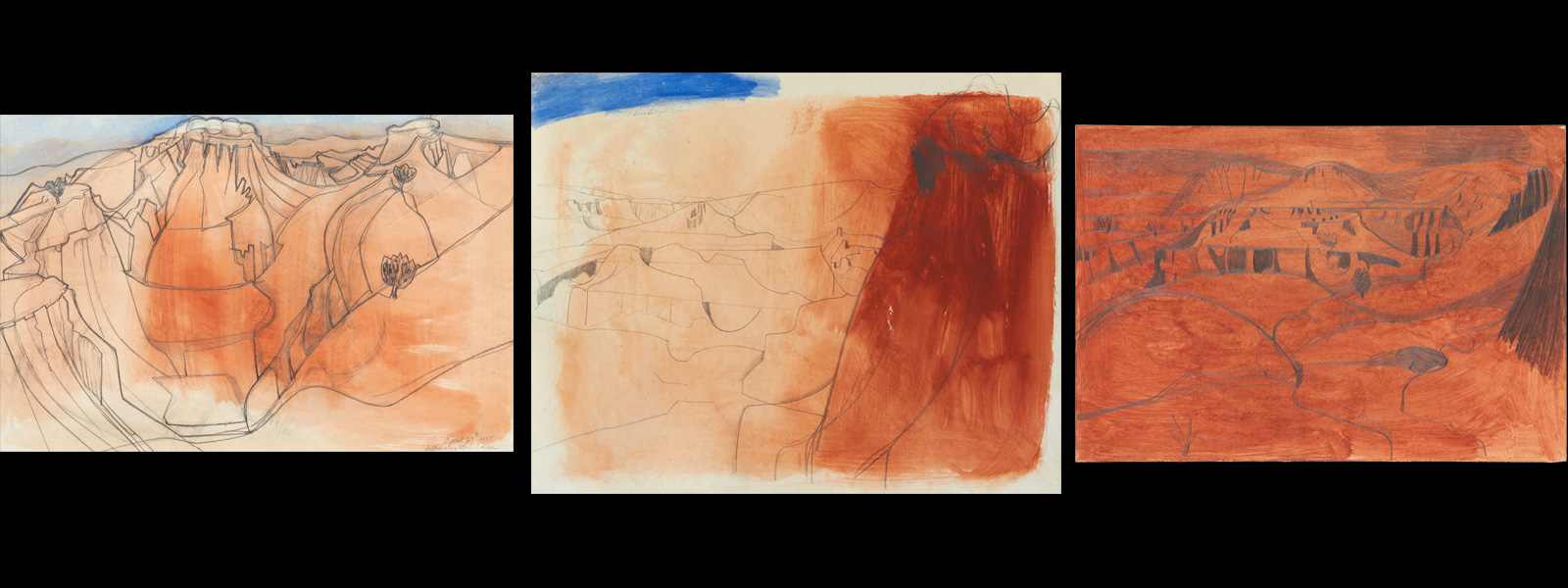They attended a British Council party for the private view of Ben Nicholson’s exhibition at the Musee d’Art Moderne. Along the way they reconnected with their old friend Krister Lagergren, with whom David Lewis was a regular correspondent.
Photo: Dinner Party, Paris, January 1955. Clockwise from bottom left – Barns-Graham, Denise René, Louis Clayeux (Gallery Maeght), his wife, Krister Lagergren, Angelica Calliyannis, David Lewis, Agnes Widlund (Gallert Samlaren), Pontus Hultén, Manolis Calliyannis, Princess Mimi Di Niscemi, Roger Hilton, unknown, Frank McEwen.
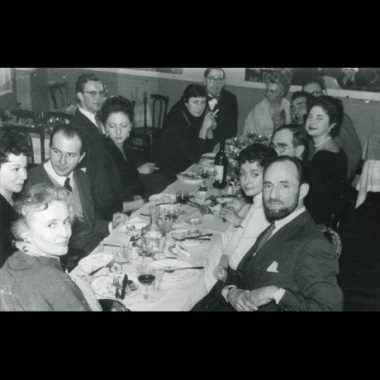
Barns-Graham and Lewis received introductions to go and view the private studios of artists including Jean Arp, Constantin Brancusi, Alberto Giocometti, and Antoine Pevsner. Barns-Graham remembered Brancusi the most vividly, writing in a 1955 letter “I was so disturbed by his work I couldn’t speak any language- to me he is the greatest sculptor living… His work filled me with profound experience… of his attitude to life.” (WBG/1/1/4/11)
They settled into the British School at Valle Giulia, Rome, “a place more like a museum than a hostel.”
Photo: Barns-Graham in Rome taken by David Lewis, 1955, BGP/3/1/4
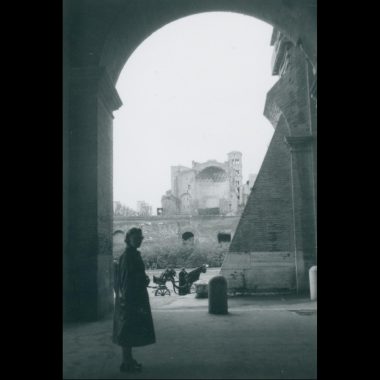
Lewis wrote in a letter to Lagergren “we are at present engaged in life & death struggles with Italian bureaucracy: I have never, not even in England, seen so many official papers” as the couple apparently struggled to collect Barns-Graham’s scholarship money and apply for a visa extension. (WBG/1/3/15/6, David Lewis to Krister Lagergren, February 1, 1955, p. 1). However, the couple did manage to get out and see St Peter’s Basilica by night.
Although the lack of any Roman drawings suggest that this period of their journey was primarily for business, pictures like this one of the Colosseum show that Barns-Graham and Lewis explored the city when they were able.
Photo: Inside the Colosseum, Rome, taken by David Lewis, BGP/3/1/5
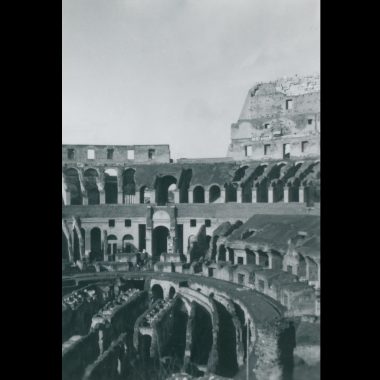
Barns-Graham consigned to Robert Schneider, Director of the Galleria Schneider in Rome, 6 reliefs to be sold on commission.
Image: A consignment note from Galleria Scheider for 6 reliefs by Barns-Graham, dated 6 February 1955, WBG/1/5
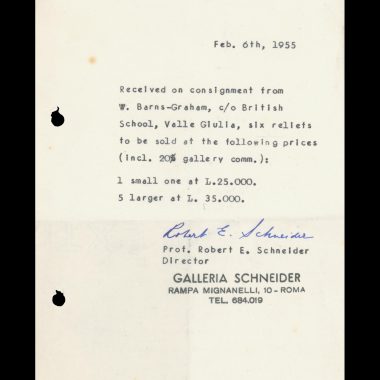
The earliest identifiable drawing of Sicily, a landscape of Monreale, is labelled “February 16th”, suggesting Barns Graham and Lewis arrived on the island a few days before this.
Lewis wrote to Lagergren from Palermo, describing their accommodation, Villa Maggiacomo, an ex-convent “built on a sharp hill over the bluest imagineable sea. We have the cloisters, and seven huge, whitewashed rooms, with panel ceilings and red tile floors. Our cloisters are high up overlooking the sea and a rocky mountainous cape called Capo di Zapparano, under which nestle two very picturesque (but unbelievably smelly) fishing villages.” (DL to KL, February 26, 1955, pp. 1-2) The couple would use Villa Maggiacomo as their base for the over two months they stayed in Sicily, leaving to go on shorter trips around the island.
Photo: A view of Villa Maggiacomo taken by David Lewis, BGP/3/1/8
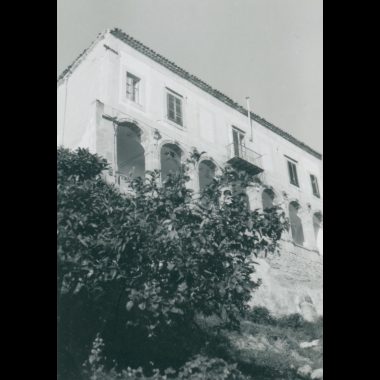
Lewis wrote to Barns-Graham’s aunt Mary Neish that “during the last fortnight we have done quite a lot of travelling” (WBG/1/2/61/1, David Lewis to Mary Neish, March 24, 1955). He mentioned travelling to Syracuse during this time specifically, but there is also archival evidence to suggest the couple went to other locations in the western half of Sicily such as Porticello, St Elia, Termini Imerese, Bagheria, and Selinunte during their trip, and may have visited some of these locations in this period as well.
Again, to Mary Neish, Lewis wrote “We enjoyed Syracuse very much, particularly the Greek Theatre – hewn directly from the white rock of a hill overlooking orange groves and the sea. There was great peace in that place.” (DL to MN, March 24, 1955)
Photo: Barns-Graham drawing on the hillside of Syracuse taken by David Lewis, BGP/3/1/69
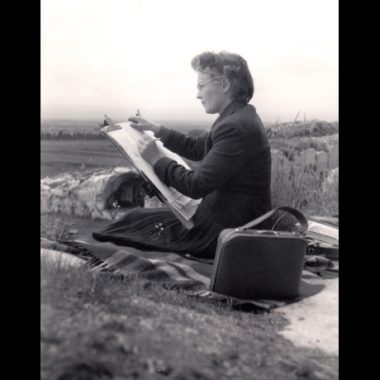
Driven around Trapani and Erice by their friends the Amorosos. Lewis described Erice as “a little saracenic town, perched on the top of a peak which rises sheer from the Trapani plain and sea level below: a road winds up to it like a snake and the town when you get there is a maze of tiny houses, courtyards and alleyways” (DL to MN, March 24, 1955). The pair seem to have met more than just Amorosos at Erice, as individuals identified as “Olly” and “Tiamina” appear in photos with Barns-Graham. These people reappear in photos of a dinner party at Villa Maggiacomo and suggest a Sicilian social life which is never commented on by either Barns-Graham or Lewis and remains a mystery.
Photo: Barns-Graham, Tiamina, an unidentified man, and Olly at Erice taken by David Lewis (BGP/3/1/33)
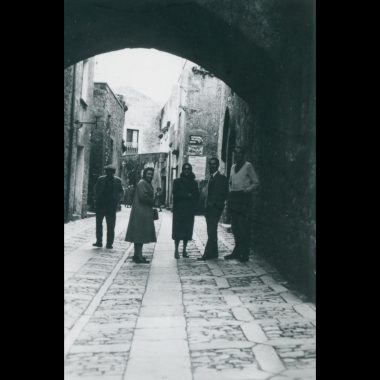
Visited the Temple of Segesta in the company of the Amorosos.
Photo: Nunzio Amoroso and Barns-Graham at Segesta taken by David Lewis, BGP/3/1/38
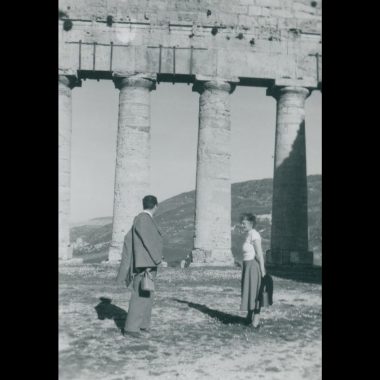
Barns-Graham dated a drawing of the Temple of Heracles to April 7th, 1955. This temple is one of many in the Valle dei Templi in Agrigento, Sicily which survives from the site’s days as the ancient Greek city of Akragas.
Image: April 7 Templi Hercules, 1955, pencil and wash on paper, BGT1673
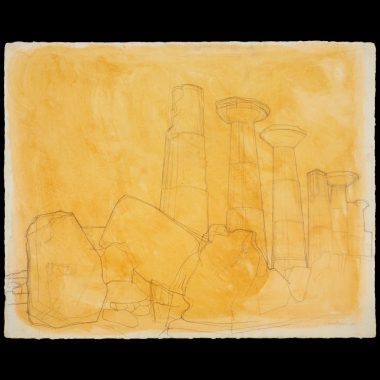
On their second day of exploring Agrigento, Barns-Graham depicted the Temple of Juno. The pair also explored the modern town, and Lewis snapped this charming picture of a man and his donkey.
Photo: A man riding a donkey taken by David Lewis, BGP/3/1/43
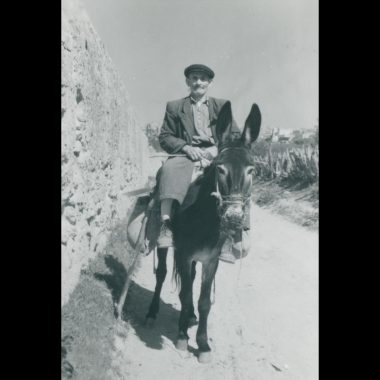
Barns-Graham spent Easter in Montallegro, a town only 31 kilometres from Agrigento.
Image: Easter Sunday Monte Allegro, 1955, pencil and wash on paper, BGT6363
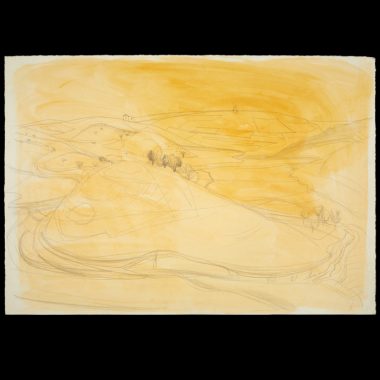
Barns-Graham and Lewis spent their last week in Sicily the coastal city of Taormina, in the eastern half of the island. Archival evidence suggests that the couple visited Enna and Catania while in Sicily, and they may have passed through these locations around this time.
Image: Barns-Graham before the Church of San Giorgio’s bell tower, in Castelmola, a village about an hour and a half walk away from Taormina, BGP/3/1/63
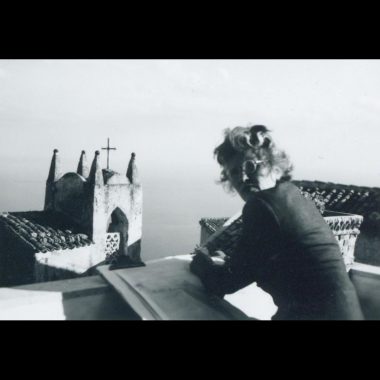
Having left Sicily to start a leisurely journey north, the couple passed through Calabria, and Barns-Graham made a series of drawings of the Canyon delle Timpe Rosse. It can be difficult to distinguish between these drawings and those made in Palinuro, Campagna because Barns-Graham often conflates the two locations in her inscriptions. Nevertheless, the region’s influence on her cannot be denied, and there exists around twenty red, rocky drawings which come from her time in the southern mainland.
Image: Palinuro Campania, 1955, mixed media on paper, BGT2297
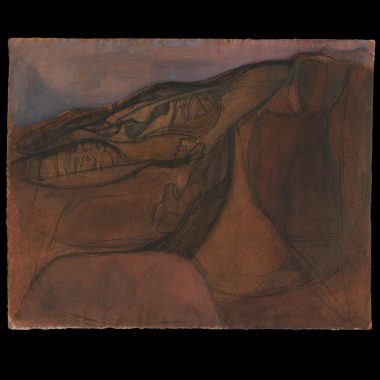
Lewis wrote to Lagergren from Palinuro, Campagna saying “we have had such peace here and sun, and swimming, and lizards and aloes and whatnot” (DL to KL, April 30, 1955, p. 1). Barns-Graham continues to draw the rocky, cavernous landscape around her.
Photo: David Lewis with one of the caves from the Grotte Marine di Capo, Palinuro in the background taken by Barns-Graham, BGP/3/1/83
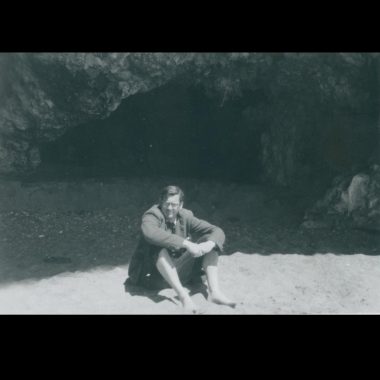
Antonio Corsaro, a journalist who the couple met in Catania, publishes a favourable review of what he has seen of her artwork, praising her for her control of light and architecture and calling Barns-Graham “concretist” which for Corsaro mean that she was truly an abstract artist, not someone whose work only imitated life. A year and a half later Corsaro had not forgotten the meeting, although looking at his letter it seems he forgot which one of them was the artist!
Image: Letter from Antonio Corsaro to David Lewis, dated 12 March 1956, WBG/1/5
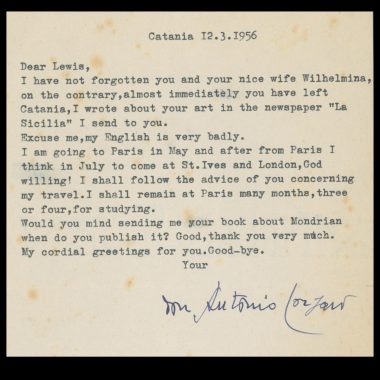
The back of Barns-Graham’s museum pass, which she received as part of her scholarship and provided her and her husband access to all archaeological and art museums during their trip, has a stamp from Pompeii. Unfortunately for the rest of the trip no letters from either Barns-Graham or Lewis have been found which detail their thoughts and feelings about what they saw and did.
Image: Photo of back of Barns-Graham’s museum pass, WBG/4/14/1/10
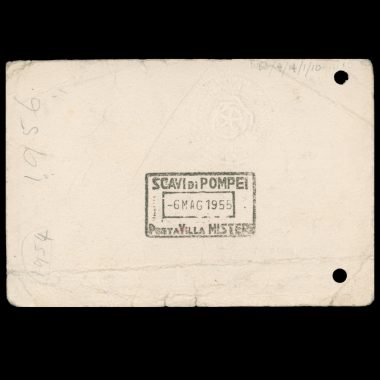
Almost nothing is known of Barns-Graham’s time in Assisi, however there are several pictures and artworks of the town, the earliest of which is dated 7 May, and the latest of which is dated 17 May.
Image: Church of San Rufino, Assisi, 1955, pencil and wash on paper, BGT6740
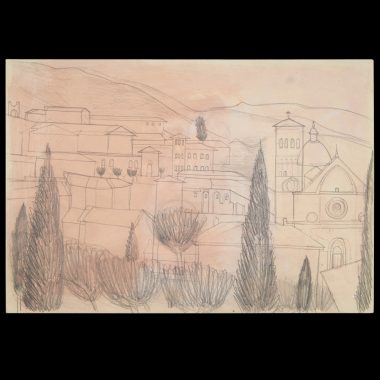
Three of Barns-Graham’s works were displayed in a Roman exhibition entitled Le arti plastiche e la civilta meccanica, hosted at the Galleria Nazionale d’Arte Moderna, Rome. Her three works on display were perhaps three of the six which Barns-Graham earlier consigned to the Galleria Schneider.
You can read more about the exhibition in this blog post.
Image: Levant, 1955, oil on board, private collection. This is one of the works shown in the exhibition.
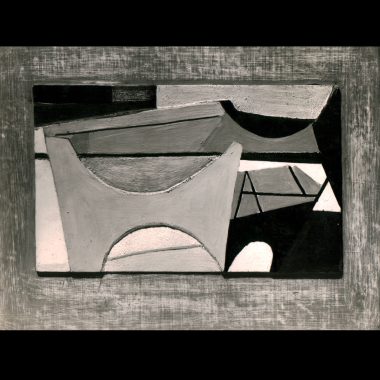
This well-stamped page of Barns-Graham’s passport confirming that she entered and then left France serves as an unassuming punctation mark to an incredible artistic journey.
Image: A page from Barns-Graham’s passport WBG/4/8/1
